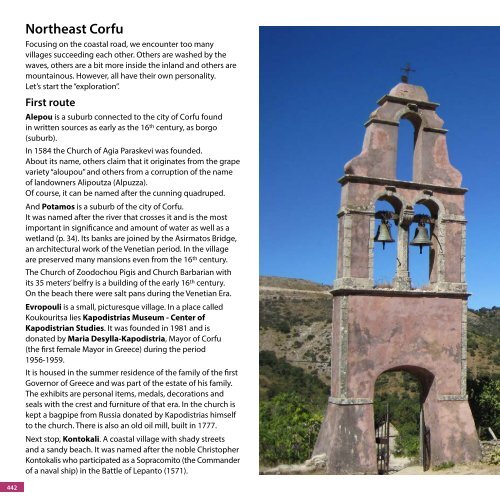Create successful ePaper yourself
Turn your PDF publications into a flip-book with our unique Google optimized e-Paper software.
Northeast Corfu<br />
Focusing on the coastal road, we encounter too many<br />
villages succeeding each other. Others are washed by the<br />
waves, others are a bit more inside the inland and others are<br />
mountainous. However, all have their own personality.<br />
Let’s start the “exploration”.<br />
First route<br />
Alepou is a suburb connected to the city of Corfu found<br />
in written sources as early as the 16 th century, as borgo<br />
(suburb).<br />
In 1584 the Church of Agia Paraskevi was founded.<br />
About its name, others claim that it originates from the grape<br />
variety “aloupou” and others from a corruption of the name<br />
of landowners Alipoutza (Alpuzza).<br />
Of course, it can be named after the cunning quadruped.<br />
And Potamos is a suburb of the city of Corfu.<br />
It was named after the river that crosses it and is the most<br />
important in significance and amount of water as well as a<br />
wetland (p. 34). Its banks are joined by the Asirmatos Bridge,<br />
an architectural work of the Venetian period. In the village<br />
are preserved many mansions even from the 16 th century.<br />
The Church of Zoodochou Pigis and Church Barbarian with<br />
its 35 meters’ belfry is a building of the early 16 th century.<br />
On the beach there were salt pans during the Venetian Era.<br />
Evropouli is a small, picturesque village. In a place called<br />
Koukouritsa lies Kapodistrias Museum - Center of<br />
Kapodistrian Studies. It was founded in 1981 and is<br />
donated by Maria Desylla-Kapodistria, Mayor of Corfu<br />
(the first female Mayor in Greece) during the period<br />
1956-1959.<br />
It is housed in the summer residence of the family of the first<br />
Governor of Greece and was part of the estate of his family.<br />
The exhibits are personal items, medals, decorations and<br />
seals with the crest and furniture of that era. In the church is<br />
kept a bagpipe from Russia donated by Kapodistrias himself<br />
to the church. There is also an old oil mill, built in 1777.<br />
Next stop, Kontokali. A coastal village with shady streets<br />
and a sandy beach. It was named after the noble Christopher<br />
Kontokalis who participated as a Sopracomito (the Commander<br />
of a naval ship) in the Βattle of Lepanto (1571).<br />
442



